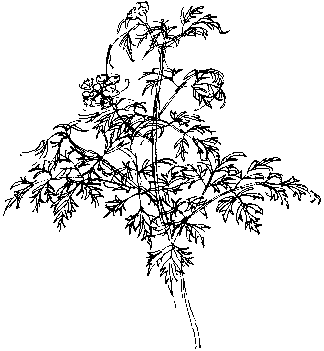 |
Wild CarrotWednesday 8th August 2001, West Yorkshire |
![]()
![]()
![]()
![]()
![]()
![]() This Month
Rocks
History
Workshop
Links
Home Page
This Month
Rocks
History
Workshop
Links
Home Page
![]()

 WITH ITS FERN-LIKE leaves and umbels of white flowers, at first glance I thought this weed in the front garden was an under-developed specimen of Cow Parsley but the feathery foliage and the spurs hanging down from the flowers show that it's Wild Carrot, Daucus carota, the ancestor of the garden variety.
WITH ITS FERN-LIKE leaves and umbels of white flowers, at first glance I thought this weed in the front garden was an under-developed specimen of Cow Parsley but the feathery foliage and the spurs hanging down from the flowers show that it's Wild Carrot, Daucus carota, the ancestor of the garden variety.It has very little in the way of a tap root; it must have taken some determined plant-breeding to arrive at today's vegetable.
Wild Carrot is typical of roadsides, grassy places and chalky soils, for example, downland and chalk clifftops. The seedheads resembles a bird's nest. The spiny seeds can be spread by any passing animal, which is probably how it originally arrived in our garden.
Culpeper on Carrots
. . . though Galen commended garden carrots highly to break wind, yet experience teacheth they breed it first, and we may thank nature for expelling it, not they; the seeds of them expel wind indeed, and so mend what the root marreth.Nicholas Culpeper (1616 - 54), English physician.
Related Link
Culpeper's Herbal complete text of The English physitian: or an astrologo-physical discourse of the vulgar herbs of this nation (1654), from a copy in the medical library of Yale University. The herbs are arranged in alphabetical order of their English names.Next page of the diary
![]()
Richard Bell,
wildlife illustrator
E-mail; 'richard@willowisland.co.uk'
![]() Next page
Previous page
This day last year
This month
Nature Diary
Home Page
Next page
Previous page
This day last year
This month
Nature Diary
Home Page
![]()